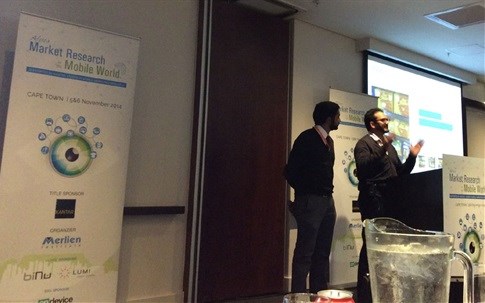Jared Patel, marketing manager of Sea Harvest, and Adhil Patel, head of thought leadership at TNS - yes, they are related, first cousins in fact - addressed the first day of the first African MRMW conference on the importance of understanding the necessary changes that take place in order to maximise the results from mobile. They also elaborated on how to get closer to the moment of purchase and consumption by capturing real context through mobile and blurring the lines between what those in the know refer to as 'qual and quant' or qualitative and quantitative research, as well as between market research and marketing.
![[MRMW] Something fishy's going on in the mobile research realm...](https://biz-file.com/c/1411/239172.jpg)
Jared gave context on Sea Harvest as a 50-year-old fishing company that's become the biggest frozen fish brand in terms of market share in the past five years, effectively overtaking I&J. This was largely due to its renewed focus on in-store activity, such as by monitoring what drives consumer behaviour - in-store promotions and the presence of price labels. He explained they had limited resources to do so, and so looked for other methods to extend this in-store activity by looking for innovative ways to make it faster, more cost-effective, more accurate and more versatile.
I don't need RESEARCH, I need useful information" Jared Patel SeaHarvest #mrmw
- Oresti Patricios (@Orestaki) November 5, 2014Adhil then spoke of importance of the visual and not necessarily changing existing questionnaire design to fit mobile but rather starting on mobile and taking it from there. He mentioned that leveraging bigger screens and cameras is important, but pointed out a big problem - research is still not seen as sexy.
People don't want to answer bland questionnaires, we have to find a better way and engage with them as people. Adhil suggests doing so through an app that repackages the idea of research as an activity to get involved in, by recruiting respondents as agents for brand.
At its heart, he says it's still about research that feels more engaging to the respondent and doesn't disrupt their day. It must feel like easy money, such as if a mission pops up on your phone while you're at the mall. This is compelling as you're already there, he explains. And that's exactly what TNS and Sea Harvest did. They got involved in ten stores in the Western Cape over a weekend, asking respondents to take photos of Sea Harvest promotions and specials in store. Another challenge they undertook was to engage with consumers and specific design for mobile by getting people to think more creatively about how they create the food, getting consumers to send in photos and verbatim comments such as the fact that their children had been watching Masterchef and wanted to help prepare food. In doing so, TNS and Sea Harvest succeeded in taking the secret agent into the home.
As proof that qualitative and quantitative research are starting to blur, as is the line between research and market research, Adhil said the people most interested in the definitions are market researchers, as anyone can create an app, add a few questions and call it market research. This has interesting implications for privacy as these apps can't really be governed, which, so researchers need to think broader as their clients are no longer interested in the mere definitions, so it's up to marketers to ensure the lines don't get too blurred.

As examples of how TNS and Sea Harvest tackled this, Adhil spoke of a shop-along audit, where a shopper talked through her decision-making process in-store, which involved the product price, as well as various flavours or toppings, her partner's preferences, and the final speed of cooking the meal. Conference attendees suggested it may be better for the participant to talk of the shipping decision-making process once complete instead of during the decision-making process, so as to not be yet another intervention. Another question was on the in-home testing aspect. This effectively places the participants in a different arena of active intervention and leapfrogs into the direct marketing space, so is it still classified as market research? Adhil responded that he honestly doesn't know and echoed Jared's earlier sentiment that he doesn't really care what it's called as the results are just so useful.
What Adhil likes about the process is that you get to essentially experiment with people, which is compelling to the client and consumer alike. Added to this, he says mobile gets you closer to the moment, but you need to think differently as the old definitions become less relevant, so it's now more about the process improving the result. He adds that this turns traditional market research on its head as consumers will want to directly interact and engage as opposed to being approached with a set of questions... but it's not all plain-sailing as ethical implications come in if you're using mobile for market research from testing a product or getting opinions and feedback.
